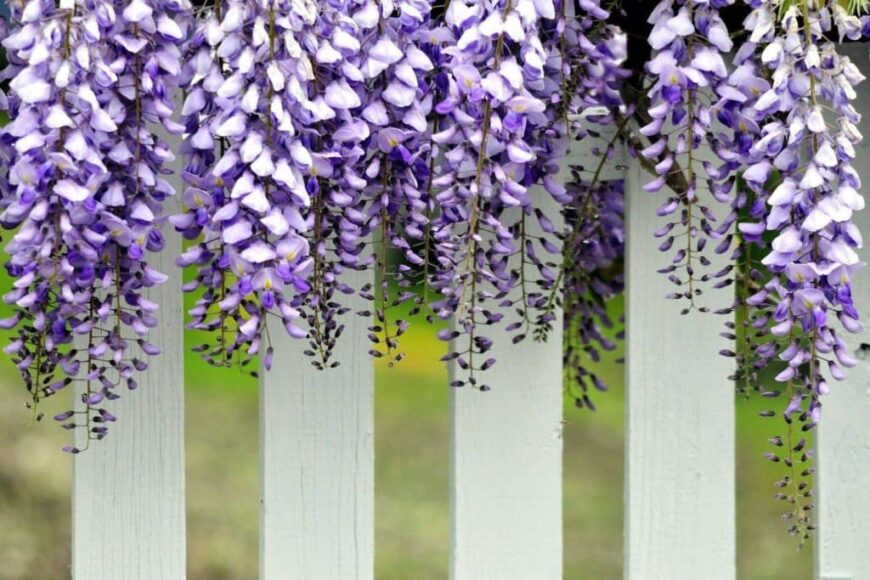
 Name: Wisteria, Alternative names: Chinese wisteria (Wisteria sinensis), Japanese wisteria (Wisteria floribunda), Korean wisteria (Wisteria brachybotrys), American wisteria (Wisteria frutescens)
Name: Wisteria, Alternative names: Chinese wisteria (Wisteria sinensis), Japanese wisteria (Wisteria floribunda), Korean wisteria (Wisteria brachybotrys), American wisteria (Wisteria frutescens) Family: Fabaceae (Leguminosae)
Family: Fabaceae (Leguminosae) Origins: East Asia, primarily China and Japan
Origins: East Asia, primarily China and Japan Humidity: Prefers moderate humidity, but can tolerate a range of conditions
Humidity: Prefers moderate humidity, but can tolerate a range of conditions Location: Full sun to partial shade
Location: Full sun to partial shade Soil: Fertile, well-drained soil with a slightly acidic to neutral pH
Soil: Fertile, well-drained soil with a slightly acidic to neutral pH Pests and diseases: Common pests include aphids, Japanese beetles, and scale insects. Common diseases include fungal leaf spots, powdery mildew, and canker diseases.
Pests and diseases: Common pests include aphids, Japanese beetles, and scale insects. Common diseases include fungal leaf spots, powdery mildew, and canker diseases. Care: Wisteria is a vigorous vine that requires regular pruning to maintain its shape and control its growth. It also needs to be watered regularly, especially during hot, dry weather.
Care: Wisteria is a vigorous vine that requires regular pruning to maintain its shape and control its growth. It also needs to be watered regularly, especially during hot, dry weather. Height of growth: Wisteria can grow up to 30 feet tall and 10 feet wide.
Height of growth: Wisteria can grow up to 30 feet tall and 10 feet wide. Planting in the soil: Wisteria should be planted in a location where it will have plenty of room to grow. The planting hole should be twice as wide and deep as the root ball.
Planting in the soil: Wisteria should be planted in a location where it will have plenty of room to grow. The planting hole should be twice as wide and deep as the root ball. Blooming: Wisteria blooms in the spring, typically from April to May. The flowers are fragrant and come in a variety of colors, including white, purple, and blue.
Blooming: Wisteria blooms in the spring, typically from April to May. The flowers are fragrant and come in a variety of colors, including white, purple, and blue. Wisteria, a captivating flowering plant belonging to the legume family, adds elegance to gardens with its cascading clusters of fragrant, pea-like flowers.
Varieties of Wisteria
Discover the beauty of different wisteria species, such as Wisteria sinensis (Chinese wisteria) and Wisteria floribunda (Japanese wisteria), each offering unique flower colors and blooming patterns.
Chinese Wisteria (Wisteria sinensis)
Explore the vigor and allure of Chinese wisteria, known for its lavender-blue flowers. The Royal Horticultural Society recommends proper pruning for enhanced flowering and growth control.
Japanese Wisteria (Wisteria floribunda)
Learn about Japanese wisteria’s longer flower clusters and color variations. Research in the Journal of Horticultural Science & Biotechnology emphasizes the importance of sunlight and well-drained soil for optimal blooming.
Planting Wisteria
Successful wisteria cultivation begins with careful consideration of location, soil conditions, and planting techniques.
Selecting the Right Location
Choose a sunny spot, as suggested by the American Society for Horticultural Science, for at least six hours of direct sunlight daily to promote healthy wisteria growth.
Soil Preparation
Create an ideal soil environment by testing and amending it, following insights from the Journal of Plant Nutrition. Well-draining soil with a slightly acidic to neutral pH is essential for wisteria.
Planting Techniques
Refer to the Arboriculture & Urban Forestry Journal for guidance on proper planting techniques. Dig a hole twice as wide as the root ball and incorporate organic matter to ensure robust root development.
Caring for Wisteria
Maintaining wisteria involves effective pruning, watering, and pest control strategies.
Pruning Techniques
A comprehensive study in the International Journal of Agriculture and Biology emphasizes the role of regular pruning in managing wisteria growth and improving flower production.
Watering Guidelines
Ensure consistent moisture, especially during dry periods, following recommendations from the Journal of Experimental Botany. Deep watering encourages deep root growth and drought tolerance.
Pest Control
Combat common pests like aphids and scale insects with environmentally friendly insecticidal soaps, as suggested by the Entomological Society of America.
Frequently Asked Questions (FAQ)
How fast does wisteria grow?
Wisteria can grow rapidly, reaching up to 10 feet in a single growing season for some varieties.
When is the best time to prune wisteria?
Prune wisteria in late winter or early spring before new growth begins for optimal results.
How do I propagate wisteria?
Explore propagation methods through seeds, cuttings, or layering, detailed in the American Nurseryman journal.
With this comprehensive guide, you’re ready to cultivate and nurture the enchanting wisteria in your garden. Whether you’re a seasoned gardener or a novice, the beauty of wisteria awaits with proper care and attention.

